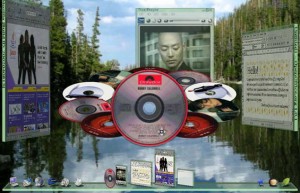 When Jonathan Schwartz, executive vice president of Sun Microsystems Inc.’s software group, was showing off "Mad Hatter" this week, it got me thinking about user interfaces.
When Jonathan Schwartz, executive vice president of Sun Microsystems Inc.’s software group, was showing off "Mad Hatter" this week, it got me thinking about user interfaces.
Mad Hatter is Sun’s attempt at taking on Windows using a Linux kernel.
But for me, the demonstration of that software at Linux World was the little picture, while another demo the company tacked on almost as an afterthought was the big picture.
According to the above referenced eWeek article, Sun also showed off a demo of "Looking Glass," a three-dimensional user interface that "used transparent, three-dimensional windows that could rotate in space and hide behind one another, drastically increasing the desktop space."
The interface we use today — a desktop with windows, icons and menus — has changed little since it was developed by Xerox in the 1970s and used on the original 128k Macintosh in 1984. Sure, Aqua throws some nice drop shadows on everything and gives us bright colors and pulsing buttons, but it’s little different from the black and white desktop of the first personal computers to use the metaphor.
The desktop has served us well. But after 30 years, shouldn’t we give it a hero’s burial?
Panther offers some neat improvements that flirt with change — Exposé gives us the ability to shrink all of our open windows to thumbnails that we can move to what we want quickly. But it’s still on the desktop. I want the whole desk.
The concept is not unattainable. In addition to Sun’s demo, Microsoft’s Longhorn operating system, due in 2005, "treats windows as transparent 3D objects." And with our ever-improving graphics chips — and now the G5 — the power is there.
There is even a project at Chalmers University of Technology in Sweden, called 3Dwm, that is working on developing such a user interface. According to the project’s white paper, "Millions of people are even today still not comfortable with using computers and are in desperate need of better user interfaces. Therefore, we may not rest, but we must instead continue to devise new and original ways of interacting with computers."
I also believe that we are just about out of innovations for the traditional two-dimensional desktop metaphor. There is little more that can be done with it. With the heaps of documents and databases that we create today, it would be much easier for even the geekiest of us to keep everything organized in our minds if we had virtual filing cabinets instead of lists painted on flat windows. Our lives are not flat, why should our interactions with computers be this way?
Apple has a tradition of taking the first step when it comes to such innovations. I fully expect that it will — but I’m hoping it will be sooner, rather than later. Our window of opportunity (pardon the pun) is quite large considering the Longhorn release date, but why wait?
Panther, scheduled to be released before the end of the year, will not include such radical changes. But with the new capabilities available with the G5 and 64-bit computing, anything less for OS X 10.4 would be treading water.


No comments
Be the first one to leave a comment.